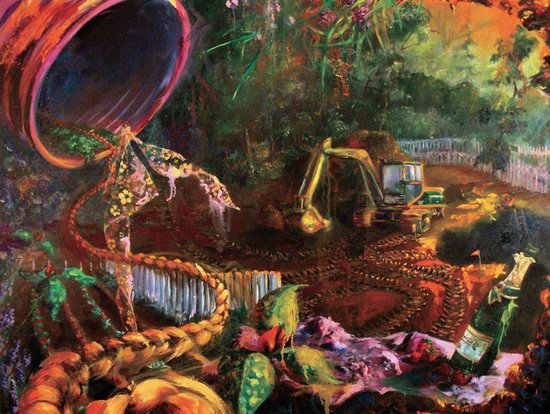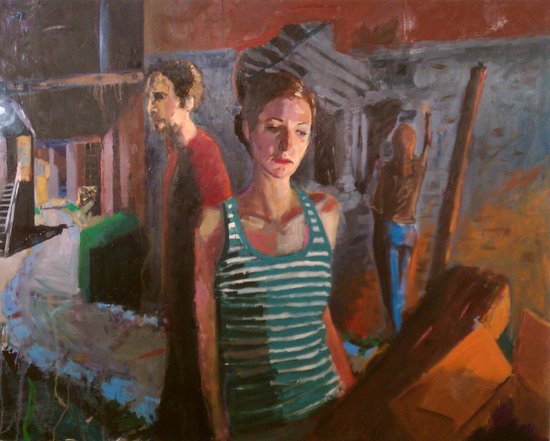A school bus sits in an overgrown field, along with an abandoned car. A pipe bursts bright liquid in the upper right corner, and a bird's nest with blue eggs rests in the lower left. Keys dangle from the pipe, and a flashlight shines on the eggs. In the distance, we see an ancient-looking door emerging from a smudgy hillside in a vague landscape.
In her artist statement, Emma Farber articulates her works' theme of overcoming life's challenges, which she communicates through the use of significant symbols. This painting, Take Shelter, presents metaphors for shelter (the nest and door) as well as the means to access it (the keys and vehicles). The school bus has been lushly rendered, with attention to detail, and the eggs have a candy-like shine that entices the viewer. The choice of symbols reads easily to the viewer.
Take Shelter is typical of Farber's six paintings on display through October at the Phoenix Gallery, located at 1530 Fifth Avenue in Moline. Along with Farber's work are five paintings by Zachary Cleve, a fellow recent graduate from St. Ambrose University. Both artists present thoughtful content and areas of strong technique but could benefit from greater unity and a sense of completion.
Farber's oil with acrylic paintings show fantasy landscapes containing scattered everyday objects. Their dreamlike quality is achieved through blurry brushwork and muted tones used for foliage and landforms, with stark lighting filtering through in areas, giving a sense of sunbeams breaking through the treetops. The images are all from an eye-level view, inviting the viewer to "walk in" to the scenes.
In Zoning, Farber deftly dictates the viewer's visual path through compositional choices. The focal point is a large drainage pipe emerging from the top left of the canvas. We are drawn to look at this, as it is large and high-contrast.
Our eyes then follow a braided rope, or hair, snaking out of the pipe and out the bottom of the composition. From there, we are led to the bottom right corner by the strongly horizontal elements of a plant and purple rumpled cloth. On the cloth are strawberries and a champagne bottle, which create a pause as the viewer stops to study the details of the label and sparkly foil top.
Next Farber pulls the viewer into the middle-ground space by following tire tracks through the mud to a parked backhoe. The backhoe is captivating, with enough detail to spark interest but still conforming to the fuzzy painting style of its surrounding distant space. Farber has captured unusually bright sunlight, creating a surreal environment as a warm light reflects off the machine's surfaces.
Many areas of Farber's paintings, such as Take Shelter and Home Base, show straight-from-the-tube paints - especially pthalo blue and green - in cases where mixing custom colors would have helped unify the works. The complexity of detail in these scenes requires color cohesion to avoid a jarring quality.
Emily does employ an effective color palette, reminiscent of surrealists such as Salvador Dali, with saturated but similar hues in the foreground objects, and an overall sanguine tone through use of warmed-up greens and blues. This influence can also be seen through her creation of textures - objects seem more gnarled or shiny than in reality.
Emily also exhibits the strongest compositional balance through its use of negative space. Farber again uses a strong visual path to lead the viewer around the perimeter of the page, finally resting on a jeweled broach hanging from a branch, mysteriously dripping purple liquid. The whole top left of the composition is light yellow sky. This element is what makes this painting effective; the presence of a relatively flat and solid space provides balance to the busy details of the grass and small objects.
Many of the objects scattered through Farber's paintings are commonly associated with visual metaphor - keys, high heels, champagne, etc. While Farber in her artist's statement described the paintings as autobiographical treatments of overcoming challenges, the juxtaposition of man-made objects in dreamy landscapes, with recurring themes of construction equipment and refuse (empty bottles, drainage pipes, abandoned vehicles), seems to more obviously imply an environmental theme or an exploration of how humans alter the landscape. The also-repeated imagery of childhood, toys, candy, and a school bus further implies some connection to memories, but in a more nebulous way.
The show's other artist, Zachary Cleve, utilizes oil on canvas to create vaguely narrative scenes, using psychological portraits to generate a mood of repression and malaise.
His subjects are placed in various dilapidated settings - an abandoned theatre, a dingy lounge, crumbling buildings. Each scene contains two to four characters, although the people do not interact with each other or the viewer. Their body language is withdrawn and listless, their clothing and hair modern yet nondescript.
At the center of the composition of Moulder is a woman, visible from waist up, standing next to a pile of rubble. Behind her are two other figures: a man staring to the left, and a woman in the distance, facing away. The whole scene takes place outside of a crumbling building.
The woman in the foreground is rendered with strong technique. Cleve has employed large, visible brushstrokes, and thick layering. The portraits in the foreground use areas of subtly abstracted color; instead of a straightforward flesh tone, Cleve has added blue and red hues. This application of expressive color meeting realism recalls the portraits of Lucian Freud. Drips and more frenzied brushstrokes in the background enhance the building's tattered appearance.
Vigil is also a strong work, again because of Cleve's portrait technique. Taking place inside the ruins of a building, a man in the foreground looks off to the right, alert and pulling aside a leafy vine. Also present are a walking woman and a figure, with his back to us, sitting on a pile of debris. The foreground portrait shows the best of Cleve's technique - utilizing color to create expressionistic style, with attention to realistic details such as the texture of the man's facial hair.
Cleve is successful in capturing a tone of awkward social apathy through the body language and facial expressions of his subjects, the dilapidated settings, and the dark and earthy colors.
But compared to the portraits, the other space in the paintings falls short. It is unclear if the backgrounds are intended to be vague or realistic - so they require a push further in one of those directions. They lack textural diversity and seem rushed and incomplete, missing the depth of color layering and detail present in the portraits. There are also areas that contain distracting mistakes of perspective or proportion.
Both artists have a similar inclination to paint dominant elements of their pieces extremely well. Farber seems to focus on a few objects in each work, while Cleve concentrates on the portraits. I look forward to seeing what they can do when they address the whole canvas with the attention they've paid to their primary subjects.
Phoenix Gallery is open Wednesdays through Saturdays 6 to 9 p.m. and by appointment. For more information, visit AtThePhoenix.com.
Michelle Garrison is a mixed-media artist who teaches art and design at Geneseo Middle School.












